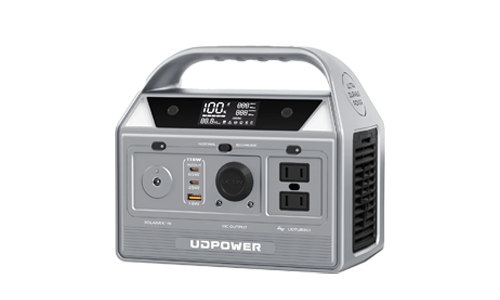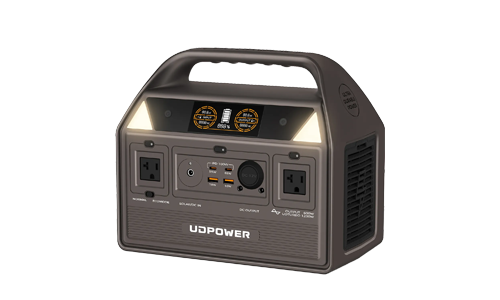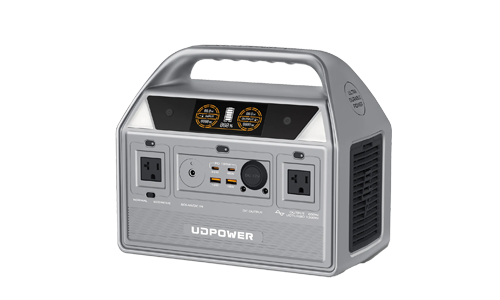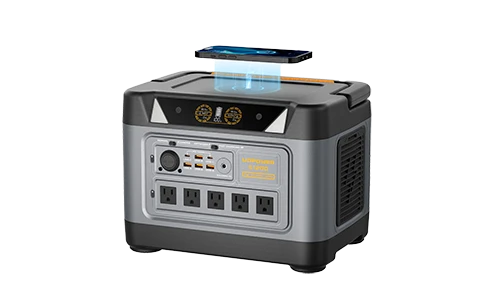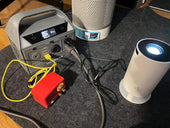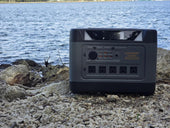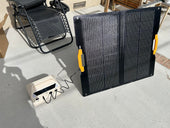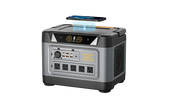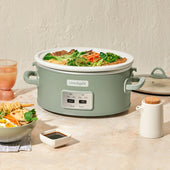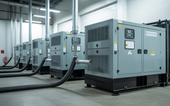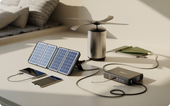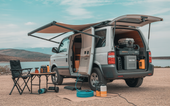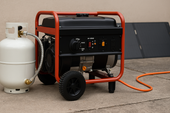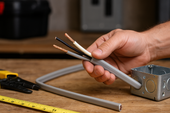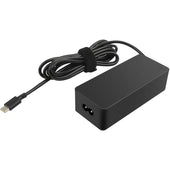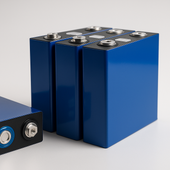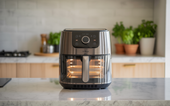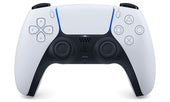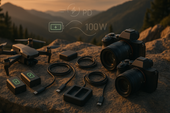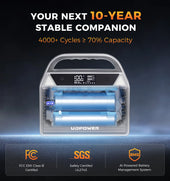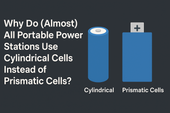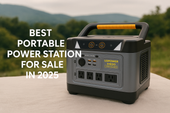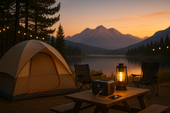How Does a Portable Air Cooler Work?
William ZacharyPortable air coolers—also called evaporative or “swamp” coolers—drop air temperature by evaporating water, not by using a compressor. This guide goes beyond the basics: psychrometrics, climate limits, energy math, water consumption, sizing (CFM), maintenance, and a realistic head-to-head with portable AC. Two interactive tools help you estimate cooling & off-grid runtime and room size/airflow & water use.

What a Portable Air Cooler Actually Does
A portable air cooler pulls hot, dry air through wet pads. A small pump wets the pads; a fan drives airflow. As water evaporates, it absorbs heat—called the latent heat of vaporization—so outlet air gets cooler (and more humid).
- Fan: Drives airflow (often 30–120 W in portables).
- Water pump: Circulates water across pads (≈5–20 W).
- Pads: Honeycomb or aspen media; thicker, denser pads improve cooling but need more fan power.
- Tank & controls: Reservoir size determines refill intervals; speed/pump/swing settings shape comfort.
The Science: Wet-Bulb, Enthalpy & Realistic Temperature Drop
Wet-Bulb Temperature = The Lower Limit
For a given dry-bulb temperature (Tdb) and relative humidity (RH), the wet-bulb temperature (Twb) is the theoretical floor. A cooler’s pad efficiency (η) determines how close you get:
Outlet Temp ≈ Tdb − η · (Tdb − Twb)
Typical pad efficiency: 60–80% for portable units in good condition.
Enthalpy & Water Use
Every kilogram of water evaporated removes ~2,257 kJ (≈0.626 kWh) of heat from the air. That’s why adding water—rather than power—is central to cooling capacity.
Rule of thumb: Evaporating 1 L/h provides ~0.626 kWh/h (≈0.626 kW) of cooling.
Climate Limits: When Air Coolers Shine (and When They Don’t)
Strong Performance
- Hot-dry air: RH < 35–40% or dew point < ~55°F.
- Open or semi-open spaces: patios, warehouses, garages, tents—constant fresh-air exchange.
- High-altitude deserts: bigger wet-bulb depression => bigger temperature drop.
Limited Performance
- Humid air: RH ≥ 60% severely limits cooling; air can feel clammy.
- Sealed rooms: humidity accumulates; crack windows/doors to maintain flow.
- Precision cooling: when you need exact setpoints and dehumidification, use AC.
Sizing by Airflow (CFM): Match Cooler to Room Volume
Evaporative cooling loves air changes. A practical planning range for portables is 15–25 ACH (air changes per hour) in enclosed rooms with ventilation. Required airflow:
CFM ≈ (Room Volume in ft³ × ACH) / 60
- Small room (1,200 ft³) @ 20 ACH → ≈ 400 CFM
- Garage bay (4,000 ft³) @ 20 ACH → ≈ 1,333 CFM
- Open spaces need more CFM to feel a breeze; aim for directional airflow across occupants.
Energy Use, Water Use & Cost of Ownership
Power Draw
Portables typically draw 50–150 W (fan + pump). That’s an order of magnitude lower than portable AC (800–1,400 W). The trade-off: you add humidity, and cooling depends on outdoor air conditions.
Water Consumption
Water use scales with cooling delivered. A handy estimate from airflow and temperature drop is:
Water (L/h) ≈ 0.000506 × CFM × ΔT(°F)
Example: 900 CFM and 12°F drop → ~5.5 L/h.
Interactive Tool #1 — Cooling & Off-Grid Runtime Estimator
Estimate outlet temperature from wet-bulb depression and how long you can run the cooler from a battery power station. Uses a wet-bulb approximation and simple energy math.
Estimated Outlet Air
—
Approximate discharge temperature after pads.
Expected Drop (ΔT)
—
Cooling relative to ambient air.
Runtime on Battery
—
Based on total watts and inverter efficiency.
Example runtimes with UDPOWER S1200 (≈1,190 Wh, η=0.85)
| Cooler draw | Usable Wh | Estimated runtime |
|---|---|---|
| 40 W | ≈1012 Wh | ≈25.3 hours |
| 70 W | ≈1012 Wh | ≈14.5 hours |
| 120 W | ≈1012 Wh | ≈8.4 hours |
| 180 W | ≈1012 Wh | ≈5.6 hours |
Interactive Tool #2 — Room-Size / CFM & Water-Use Estimator
Match cooler airflow to room volume and estimate water consumption from airflow and temperature drop.
Required CFM (Room)
—
Based on volume and selected air changes per hour.
Estimated Water Use
—
Using Water ≈ 0.000506 × CFM × ΔT (L/h).
Cooling Capacity (approx.)
—
From airflow & ΔT (BTU/h and kW).
These are planning estimates; ventilation, pad quality, and weather will shift results.
Portable Air Cooler vs. Portable Air Conditioner
| Factor | Portable Air Cooler | Portable AC (Single/Dual-Hose) |
|---|---|---|
| Cooling method | Evaporation (adds humidity) | Refrigeration cycle (removes humidity) |
| Power draw | ~50–150 W | ~800–1,400 W |
| Best climate | Hot-dry, semi-open spaces | Any climate (needs venting) |
| Ventilation | Window/door open to flush humidity | Window kit to exhaust hot air |
| Water use | Yes (several L/h typical) | No (produces condensate) |
| Off-grid friendly | Excellent (low watts) | Difficult (high watts) |
| Comfort feel | Cool breeze + moisture | Cool, dry air at setpoint |
Powering Your Cooler Off-Grid: UDPOWER S1200
The UDPOWER S1200 is a LiFePO₄ portable power station with about 1,190 Wh of capacity, 1,200 W AC output (surge up to 1,800 W), a quick UPS-style switchover, and a handy wireless charging pad (drop your Qi/Qi2 phone while the cooler runs). Its chemistry supports long cycle life, and the power headroom covers most portable coolers plus lights and electronics.
- Practical runtime: See the tool above (e.g., ~14.5 h at 70 W, inverter η=0.85).
- Flexible recharging: AC wall, car, or solar (panels optional).
- Everyday convenience: Wireless phone charging and multiple DC/AC outputs.

LiFePO₄
Care, Hygiene & Safety
- Ventilation first: Keep a window/door cracked to avoid humidity buildup.
- Pad hygiene: Rinse/replace pads as directed; stagnant water can cause odors and biofilm.
- Water quality: Mineral-heavy water shortens pad life; consider filtered water in hard-water regions.
- Tank discipline: Drain before storage or transport; wipe the reservoir to prevent mold.
- Electrical safety: Keep cords and the power station away from splashes; use GFCI-protected outlets where appropriate.
FAQ
Can a portable cooler chill a sealed bedroom?
Only with ventilation. Without fresh-air exchange, humidity climbs and cooling stalls. Crack a window/door and aim airflow across occupants.
Does adding ice make a big difference?
Cooler inlet water helps a bit, but overall comfort is dominated by wet-bulb depression, airflow (CFM), pad condition, and ventilation.
How loud are portable coolers?
Similar to a strong box fan. Larger CFM units are louder; look for variable speed and night modes.
What’s the most important spec?
For cooling feel: CFM matched to space and pad efficiency, plus good ventilation. For off-grid: total watts and battery runtime.
Buyer’s Checklist
- Airflow (CFM) sized to your room volume (see Tool #2).
- Pad quality (thickness, honeycomb density) and easy access for cleaning.
- Tank size vs. expected water use (L/h).
- Power (fan + pump watts) and noise level.
- Controls (multiple fan speeds, pump on/off, swing louver, timer).
- Mobility (casters, handle) and footprint.
- Serviceability (filters, pads, pump spares).
- Off-grid fit (runtime with your power station; recharge options).


